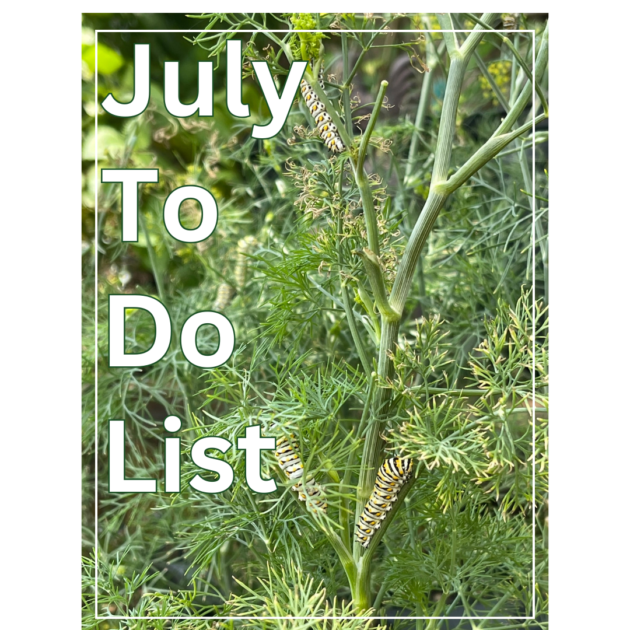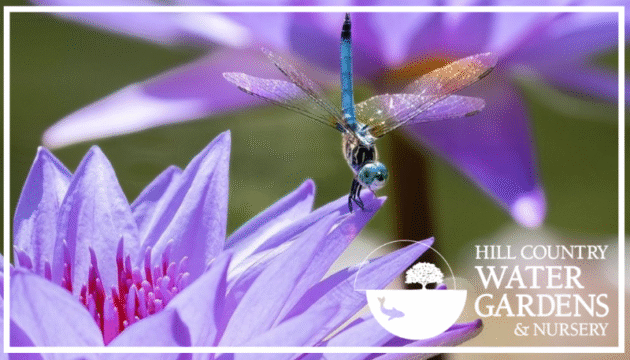Category Conservation, Fertilizers, Flowers!, Gardening, Landscape, Lawn Care, Organic Pest Control, Perennials, Pruning, Shrubs, To Do, Trees, Vegetable Gardens
July 10, 2025

July To Do for Central Texans
Landscape Planting:
We can plant year-round in Central Texas! So far the summer of 2025 has been fairly rainy, and this can make planting a little easier on the planter and the plant. Watch new plantings carefully at this time. Automatic Watering systems may be enough to keep an established landscape looking good but new transplants MAY need an extra drink from time to time!
All landscape plants should look well-watered, not wilting, in the early morning hours! As the summer day progresses, some plants will wilt to conserve water. As the sun lowers and the temperature falls, these plants SHOULD perk back up – this is what we refer to as “Mid-Day Melt”.
A plant wilting in the morning hours is in TROUBLE and should receive a slow, deep soaking ASAP! Often, new transplants will look great in the morning and “melt” in the afternoon to conserve moisture as it establishes its root systems.
Pro Tip: If you’re heading on an extended business trip or a Disney World family vacation, buy and plant your plants when you get back home! You need to be around just in case.
“The best gardens grow in the shade of the gardener.”
-Unknown
Fertilizing:
Beware! Over-fertilizing in the summer can cause “burn” and even plant death. Using salt-based/chemical fertilizers is often the culprit. We often see photos of burnt lawns in the summer! Don’t fall victim to (bad) advertising!
Annuals like Vinca, Coleus, Crossandra, petunias, and many others CAN be fed with chemical or organic fertilizers, and the results will be noticeable. These plants have only one season to make offspring, and they need extra food to continue to bloom (make seeds).
Planted trees, shrubs, perennials, herbs, and lawns generally do not need summer fertilization. We WILL recommend MicroLife’s Humates Plus if your landscape plants are struggling. With an N-P-K of 0-0-4, Humates Plus only contains Potassium macronutrient, and not any nitrogen or phosphorus. Extra ingredients like yucca extract, kelp, molasses, and beneficial microorganisms to boost soil fertility and water absorption without forcing new, often unsustainable, new growth!
Your potted plants may need a gentle, complete food like MicroLife Acidified (contains extra sulfur to counteract our high pH irrigation water) can be worked into the potting mix. MicroLife’s liquid fertilizers like Biomatrix, Super Blooms. Ocean Harvest, or Super Seaweed are excellent choices for feeding the summer. These foods can be applied every two weeks or once a month. With liquid plant foods, you can control the concentration to full-strength, half-strength, or even quarter-strength for cacti, tropicals, and succulents.
Insect Pests and Diseases:
Warmer day and night temperatures are perfect for pest reproduction. The recent excessive rains and temperatures can contribute to foliar and root fungal issues. Keeping a close eye on your plants will help control any problems that could get out of hand quickly. Adding MicroLife’s Humates Plus or their MicroGro Bio Inoculant
In most pest issues like aphids, spider mites, and mealy bugs can be controlled by spraying them off with water once or twice before our natural predators find the new food source.
In more complicated or stubborn insect cases, we will recommend Safer Soap or organic oils. We will not recommend broad-spectrum insect killer out of fear for harming our local pollinators!
Please feel free to send us close-up photos to 512-560-6788 or bring in ziplocked samples for identification and advice.
Pruning:
Roses, shrubs, and perennials may pause their blooming cycle with warmer July temperatures. Dead heading and or light pruning to shape the plant is ok in July. Prune no more than one-fourth to one-third of the overall size of the plant. Shrub roses can be pruned anytime but usually we will wait until Labor Day.
After pruning, we do not recommend feeding. Let your landscape plants flush with new growth naturally.
Avoid pruning your early spring blooming woody plants like Hydrangeas, Carolina Jessamine, and Primrose Jasmine. You’ll prune these plants AFTER they flower nest year!
It is safe to prune your Red and Live Oaks now. Be sure to clean the tools between trimming each tree with a 1:10 bleach solution to avoid spreading Oak Wilt disease. Immediately paint the wound with pruning sealer or spray paint after making each cut. This habit will help to ensure EVERY wound is protected and none are missed.
Fruit Trees and Blackberries and be pruned now!
Lawns:
Kill it*. Lawns are costly, require constant upkeep, are generally a point of pollution for toxic chemicals, and are not conducive to a healthy, diverse ecosystem. There are so many options and design ideas to replace lawns in central Texas! But, if you must have a lawn… even a tiny lawn area, below you’ll find the best recommendations for the top universities in our great state!
*We are cool with native Buffalo Grass and some of the naïve mixes. These too should be used where necessary in a design. We’re also cool with life supporting alt-lawns designed with many low-growing native species.
To prevent common fungal infections, only irrigate lawns in the early morning hours. This will allow the leaf blades to dry before leaf attacking fungi can take hold.
Summer fertilization of lawns can:
-
Burn the lawn if over applied.
-
Create weakened cell-walls to allow fungal infections.
-
Create high irrigation demand and mowing frequency.
Irrigate lawns deeply and infrequently promotes deeper rooting and discourages fungal infections.
Remove no more than 1/3 of the leaf blade at each mowing to promote a healthy balance of root to shoot growth.
Mow your lawn to the appropriate height!
Bermuda: 1 to 2 inches
Native Buffalo: 2.5 to 3 inches (if at all!)
St. Augustine: 3 to 3.5 inches
Zoysia: 2 inches
Remember: Taller Blades = more root-zone shade!
Allow grass clipping to fall in place to decompose (for better soil) or bag the clipping and add them to your compost for a great source of “green” nitrogen.
Look for signs of Take-All-Root-Root (TARR) where there are developing bare spots. Watch hot, dry areas for Chinch Bugs. The often attack near sidewalks, driveways or other concrete features where the radiant heat dries the soil.
Planting Veggies:
Herbs can be planted year-round for the most part! We’re waiting for cooler weather for the next Cilantro season. Culantro can be grown now if you can find it!
Plant Now:
Plant Pumpkin seeds now for an autumn harvest. Be sure to keep the soil moist!
Plant Southern Peas
Plant Okra
Plant Sweet Corn
Plant Malabar Spinach
Sow seeds of tomatoes, peppers, and eggplant for planting late July/early August.
Prepare your garden by adding compost and mulch before the fall crops are planted. Monitor soil moisture levels in bare planting beds. We don’t want the soil to completely dry out before the planting season begins. Keep the soil moist if possible!
Williamson County Vegetable Planting Guide*
Travis County Vegetable Planting Guide*
*These are only guides. Each year the weather is a little different and slight adjustments should be made! If it’s 110 degrees this week and highs in the 80s next week. Make that adjustment and wait a week!






You must be logged in to post a comment.